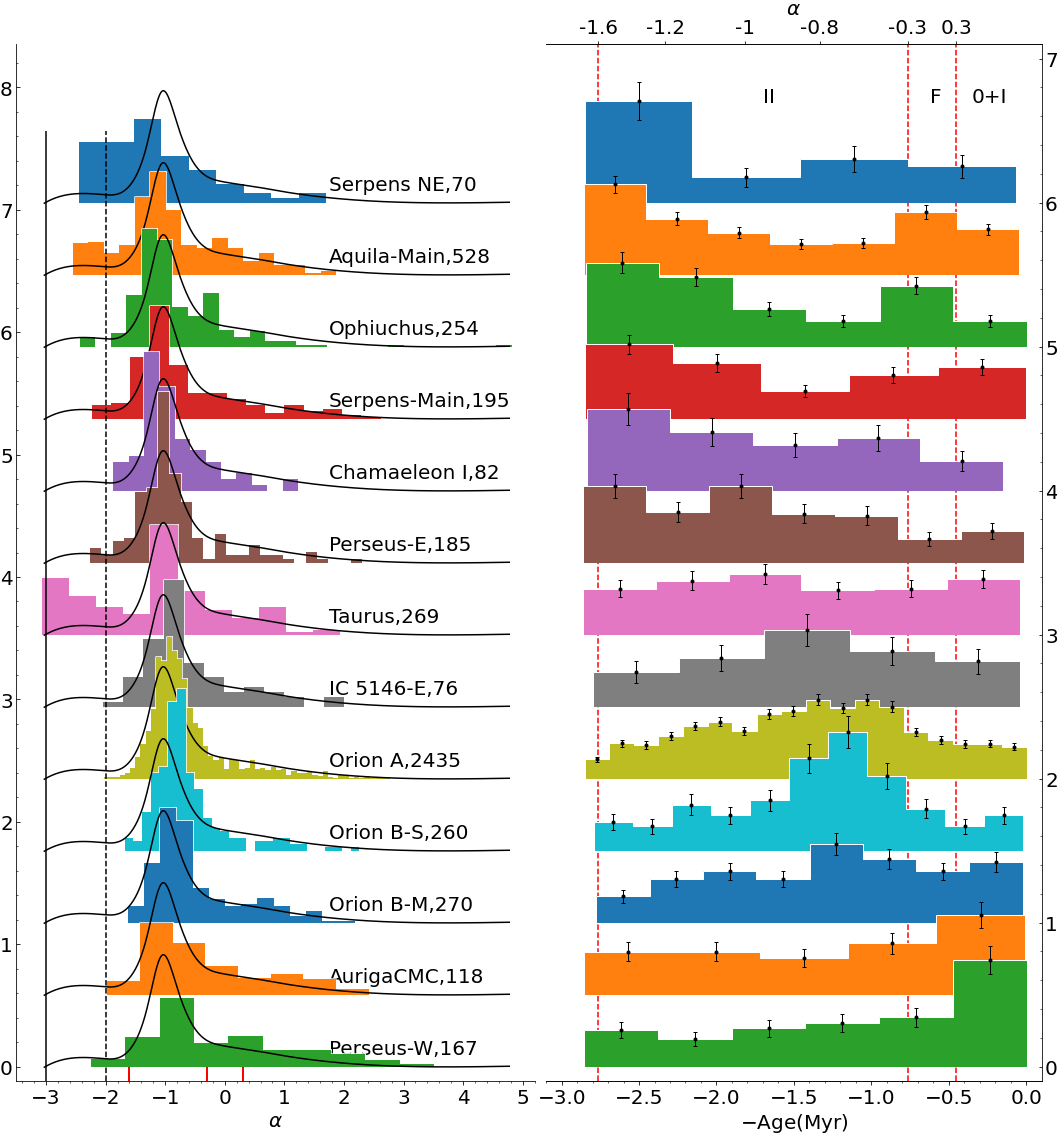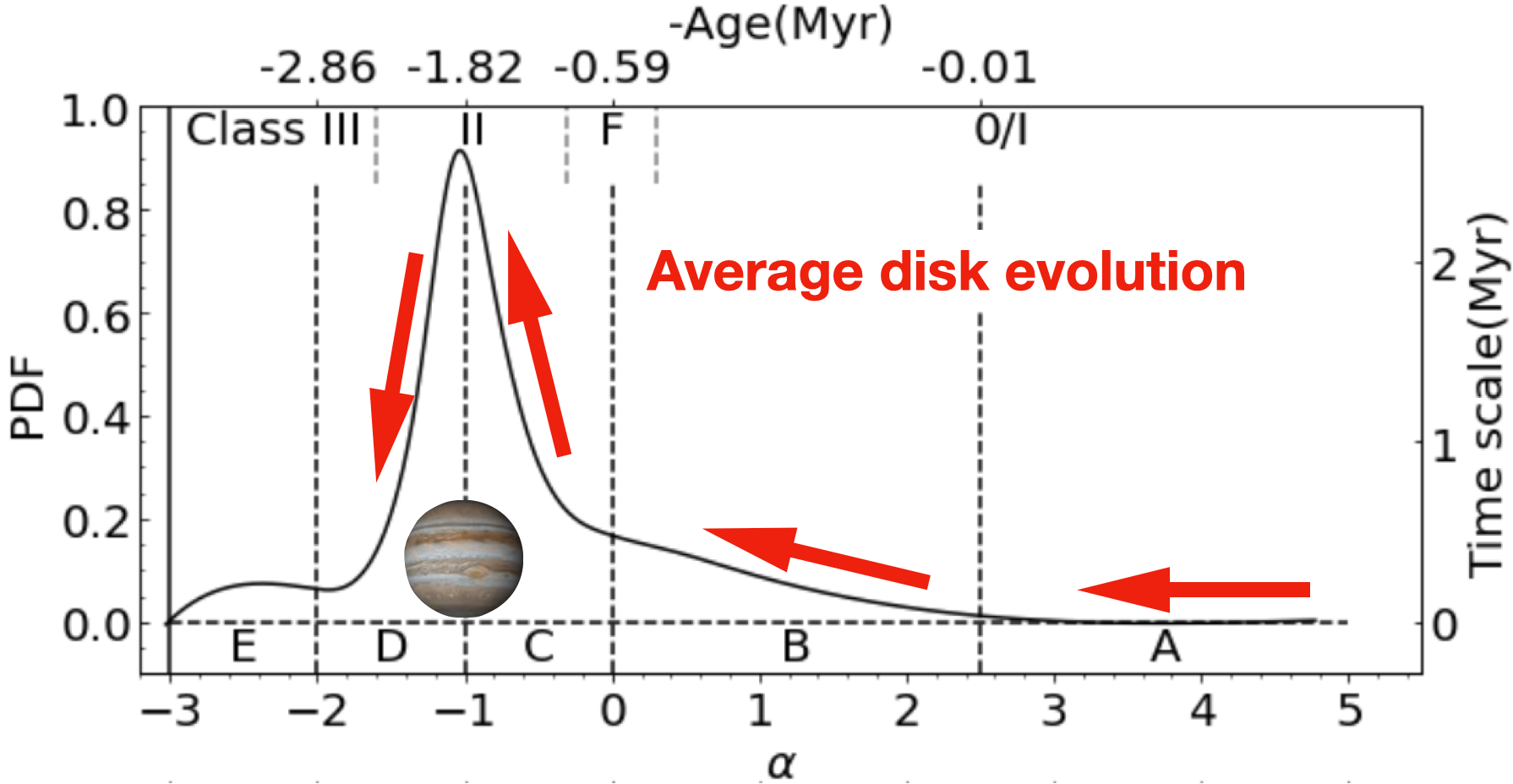The protoplanetary disk is an circumstellar structure that stars like the Sun must carry when they are born, and it is also the cradle for the birth of planets like the Earth. The evolution of protoplanetary disks is of great significance for understanding the origin of life on Earth but involves complex physical and chemical processes. Although people have a preliminary understanding of these evolutionary processes, the theoretical picture is still very incomplete. For example, the time scale of each evolutionary process is still poorly understood.
Astronomers have invented a parameter space called the Hertzsprung-Russell diagram (HRD) through theoretical calculations and simulations of infant stars that are being formed, which can roughly estimate the evolutionary age of these celestial systems. However, this stellar age is very inaccurate in the first few million years when the protoplanetary disks spend their lives, so it is of limited help in understanding the evolution of the protoplanetary disk.
In astronomical observations, because the temperature of the dust and gas in protoplanetary disks is usually only about tens to hundreds of Kelvin, their radiation mainly appears in the infrared band. The infrared survey of the Spitzer Space Telescope launched by NASA in 2003 provided a precious opportunity to study the evolution of protoplanetary disks. In particular, the telescope's imaging survey observations of nearby star-forming regions in the so-called Gould Belt provided high-quality data for this type of research.
A collaborative team consisting of Dr. HE Jinhua, a scholar of Yunnan Observatories, Chinese Academy of Sciences (YNAO) who is currently a long term visitor in the Chinese Academy of Sciences South American Center for Astronomy (CASSACA) in Chile, and PhD student LIU Mingchao , et al., through a systematic analysis of these infrared data, discovered for the first time the method to directly date protoplanetary disks through infrared radiation.
They conducted a statistical analysis of the slopes of the infrared (IR) spectral energy distributions (SEDs) of the member stars of the 13 largest protoclusters in the Spitzer Gould Belt Surveys and found that the histograms of these clusters are very similar. Especially, they all show a peak around. This similarity, which has been neglected by previous researchers, indicates that these histograms mainly reflect the intrinsic evolutionary properties of the protoplanetary disk, rather than the random fluctuations of the star formation rate. By averaging these histograms, they obtained a quantitative relationship that directly converts the observed of a disk into its age, that is, the first chronometer for protoplanetary disks within the past three million years (3 Myr). Using the ages of the member disk sources obtained by this method, they also obtained the star formation history of each nearby protocluster in the Gould Belt for the first time
They also reclassified the disk evolution process into five more observationally statistically sound stages based on the characteristics of the average histogram that reflects the intrinsic evolution of protoplanetary disks. This new classification scheme is a significant improvement to the classic classification system based on IR SED slope. It maps better to the current understanding of the physical process of protoplanetary disk evolution.
It is particularly worth mentioning that they also proposed that the statistical peak around might correspond to the maturity moment of gas giant planets similar to Jupiter and Saturn in the solar system. Their accretion of disk gas destroys the stable structure of the protoplanetary disk, thereby accelerating the dissipation of the protoplanetary disk and ending the disk life.
The discovery of IR chronometer of protoplanetary disks has opened a new window for observational studies of star formation. Protoplanetary disk is an important feature in the star formation process. Thus, its age can be used as a measure of the star formation age so that the time dimension of the star and cluster formation process can be easily included in the scope of quantitative studies. For example, the space-time structures of the Gould Belt protoclusters will be the next exploration topic of this collaborative team.

Figure 1, the left column shows the histograms of the IR SED slope (α) of 13 nearby protostar clusters in the Goud Belt as surveyed by the Spitzer Space Telescope. It shows similar peaks around. The black curve is the distribution of after averaging over all star clusters, representing the evolution time scale of an average disk at different values. The right coloumn are histograms of the ages of the member disks of each protostar cluster. It shows the history of the fluctuations in the star formation rate of each protostar cluster. Figure made by LIU.

Figure 2, a new division scheme for the disk evolution (or star formation) stages defined on the average histogram (black curve): ABCDE, and its correspondence with the classical SED classification scheme 0/I/F/II/III. The red arrows indicate the evolutionary direction of an "average protoplanetary disk", while the numbers at the top indicate the disk ages corresponding to the boundaries of the five evolutionary stages. The position of probably corresponds to the moment when the gas giant planets mature, which is what causes the disk evolution trend to suddenly turn from deceleration of evolution (upward red arrow) to acceleration of evolution (downward red arrow) at this peak point. Figure made by LIU and marked up by HE.

Figure 3, this cartoon illustrates the physical features corresponding to the five newly defined disk evolution stages: Before A - starless core collapse stage; A - a short bipolar jet start-up stage, which is only visible in the infrared band when observing through the bipolar cavities; B - the bipolar jet cavity expands rapidly, and then the cavity expansion rate slows down, and the probability of being observed in the infrared band gradually increases; C - a dust wall is formed at the inner edge of the disk to shield and protect part of the outer disk against the evaporation by the ultraviolet radiation of the central star, and the outer geometrically thick disk may still be slowly evaporating and losing, the disk structure tends to be stable, the evolution of the IR SED slows down significantly, and the slope of the IR SED approaches the peak at ; D - the gas giant planets mature, they accrete disk matter and open gaps in the disk, blocking the supply of inner disk matter, the height of the inner wall of the disk becomes shorter, and the shielding protection effect is weakened, which eventually leads to more effective irradiation of the disk gas by the ultraviolet radiation from the central star, accelerating the disk evaporation and dissipation; E - in the last stage, there is no significant dust and gas disk. The water color was drawn by hand by HE Xin and planned, scanned, edited by HE Jinhua.
Contact:
HE Jinhua
Yunnan Observatories, CAS
Email: jinhuahe@ynao.ac.cn
Reference:
Disk Dissipation, Giant Planet Formation, and Star Formation Rate Fluctuations in the 3 Myr History of Gould's Belt
Can near-to-mid Infrared Spectral Energy Distribution Quantitatively Trace Protoplanetary Disk Evolution?
IR SED slope-disk age conversion relation